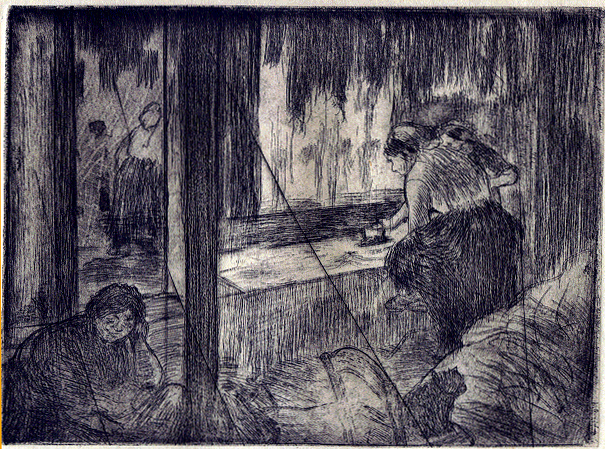
EDGAR DEGAS — Interior with Washerwomen (Post-Cancellation Proof)
Etching with Drypoint, ca. 1879–1885
Plate: Canceled (Diagonal Cancellation Mark Visible)
Image Size: Approx. [insert exact mm if known]
Asking Price: $9,500.00
Provenance: From the gallery of Pamela Hatay-Stratton
This rare etching by Edgar Degas is a post-cancellation impression, taken immediately after the copperplate was defaced with a diagonal cancellation line to mark the end of authorized printing. Despite the cancel cut, the image retains full richness, clarity, and expressive tone, with deep burr still present in the hair and garment areas—marking it as one of the earliest strikes taken after cancellation.
The composition depicts washerwomen at work—one of Degas’s most enduring themes. The interior depth and natural light evoke his painterly sensibility, while the immediacy of line and shadow reveal his mastery of drypoint.
This impression stands as a technical and historical rarity: it offers collectors an opportunity to own an authentic Degas pulled directly from the original plate, bearing both the cancel mark and the freshness of an early-state impression. Few of these exist in such condition.
🔍 Additional Notes:
-
The cancellation line (clearly visible) intersects the plate without obscuring the main narrative.
-
Trimmed close to the plate mark.
-
Plate believed to have been canceled ca. 1900 following the final supervised edition.
-
100% Guaranteed Authentic.
===========================================================================
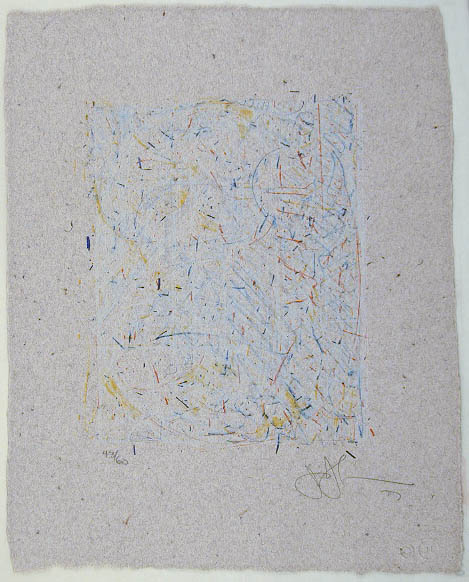
🔥 JASPER JOHNS — Zero Through Nine (0–9), 1978
Color Lithograph on Multicolored Thread Mariposa Handmade Paper
Edition of 60 — Pencil-Signed and Numbered by the Artist
Asking Price: $18,500.00
This is not the common version of Jasper Johns’ Zero Through Nine.
This is the rare, intimate variation—a smaller-format lithograph printed on handmade Mariposa paper infused with multicolored threads, giving the piece a tactile, almost sculptural presence. It’s a whisper in a world of shouts—subtle, layered, and unmistakably Johns. It is very, very rare.
-
Image Size: 162 × 126 mm (6 3/8″ × 4 15/16″)
-
Paper: Full deckled margins, as issued
-
Signed: Lower right in pencil “JJohns”
-
Numbered: 43/60, lower left
-
Condition: Pristine — no tears, no repairs, no handling issues
-
Blindstamp: Present
-
Catalogued: G. 779 / ULAE 188 / S4
-
Provenance: Sotheby’s New York 11/02/1999, Lot #1118; Gordon’s 2000, #22869
✴️ Why It Matters:
-
Only 60 exist — few collectors have even seen this variation.
-
Not mass-market — this was never widely reproduced or circulated.
-
Signed & numbered by Johns — direct connection to the artist’s hand.
-
Paper itself is part of the artwork — no two impressions are truly identical.
This is a piece for the inner circle—a collector who understands that some of the most valuable works aren’t loud, but undeniably rare.
===========================================================================
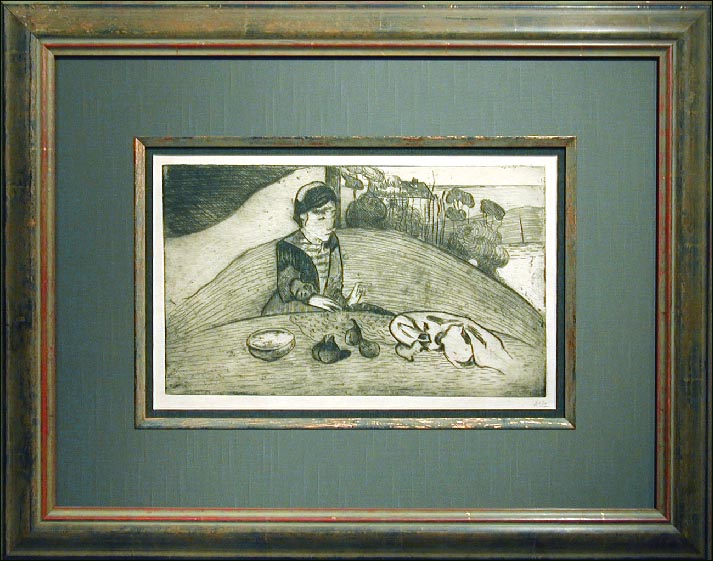
PAUL GAUGUIN — La Femme aux Figues, 1899
Etching and Aquatint (Lavis) on Zinc Plate
Guérin 88; M.K.J. 31 III/III
Plate Size: 268 × 418 mm (post-reduction)
Edition: One of 10 impressions pulled by Madame Delâtre.
Printed in the original greenish-gray ink.
This is the only etching Paul Gauguin ever made.
And he hated doing it.
But he etched La Femme aux Figues by hand, working the zinc plate in 1899 before abandoning etching entirely in favor of woodcut. Despite his distaste, the resulting print—rich with layered aquatint, lavis washes, and biting Symbolist calm—is one of the most complex and haunting in the canon of modern printmaking.
This particular impression is not from the worn 1960s strikes. It’s from the cut-down plate edition pulled by Madame Delâtre herself, before she canceled the matrix with two XX gouges near the figs.
How can we tell?
-
The plate size confirms it’s from the reduced plate: 268 × 418 mm
-
There are no XX cancellation marks
-
The inking is rich and green-gray, as in the early pulls
-
The drypoint and cross-hatching remain strong, especially around the background and fig bowl — these details vanished in later posthumous impressions.
Only 10 impressions like this were ever made—reserved for the printer’s own archive!
💎 Why This Matters:
-
Not posthumous (the 1966 impressions are ghostlike by comparison)
-
Not a restrike
-
Not even part of the original 1899 100-edition Germinal series
-
This is rarer: one of Delâtre’s ten, likely held back from sale
🏷️ Market Value Estimate:
-
1966 restrikes (weak, murky): $7,500–$14,000.
-
Germinal edition (original plate, full size): $18,000–$30,000.
-
Delâtre’s 10: $40,000+, depending on condition and provenance. That’s this edition.
This is the kind of thing serious collectors brag about owning quietly.
==========================================================================
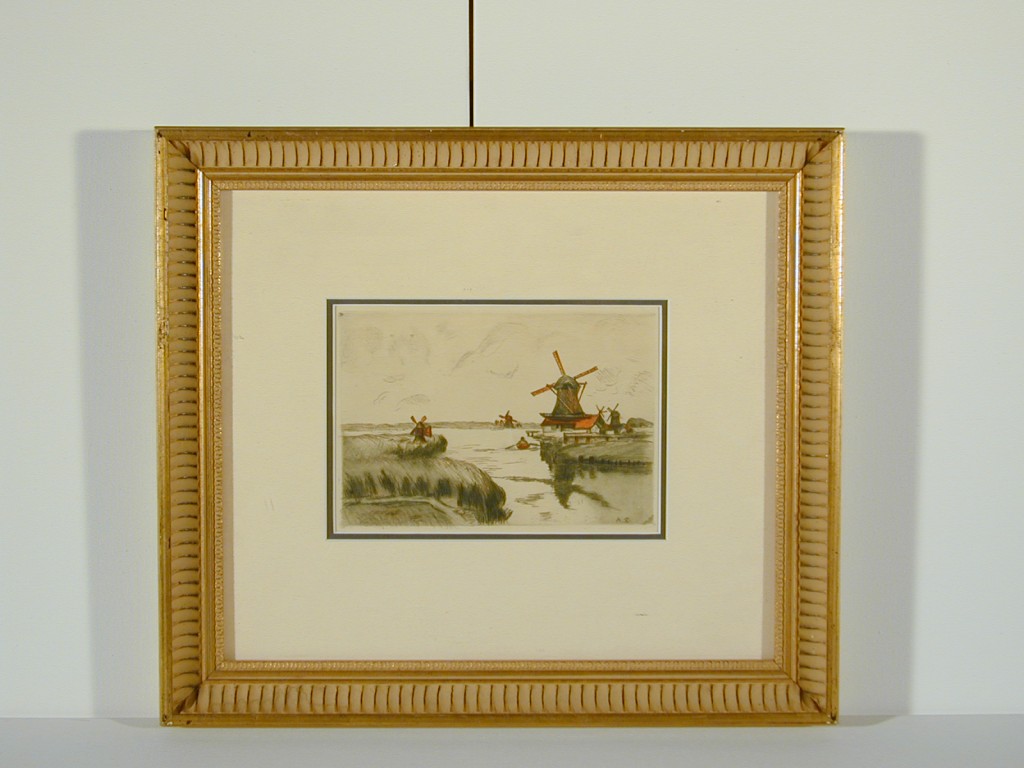
ARMAND GUILLAUMIN — Vue prise de Saardam, 1906
Original Etching from Histoire des Peintres Impressionistes
Published by Théodore Duret, Paris, 1906
Impressionist Portfolio Edition featuring Pissarro, Monet, Sisley, Renoir, Morisot, Cézanne, and Guillaumin
This is an original 1906 impression, not one of the later posthumous reprints. Etched by Guillaumin and published in the prestigious portfolio Histoire des Peintres Impressionistes, edited by Théodore Duret, this work reflects the dark, rich tonal quality of first-edition French intaglio printing.
-
Image: Vue prise de Saardam (View from Zaandam, Netherlands)
-
Technique: Etching on laid paper with full original margins
-
Printed in 1906, Paris — not from later editions
-
Impression: Deep, dark, and clean—an early pull
-
Condition: No tears, stains, or repairs; previously exhibited
-
Exhibition History: Included in a major Impressionist show.
“You can find later impressions for less, sure. But if you want that early-state depth and density—the kind of image that glows in the shadows—you go for the 1906. I’ve priced this at $1,850, not because it’s cheap, but because I happen to have a second copy in my private collection. If I didn’t? I’d be asking over $11,000 just to replace it—if I could find another this good.”
🔖 Price: $1,850 (gallery-direct)
Collectors looking to build or complete a portfolio of Duret’s 1906 Impressionists will recognize this piece as one of the more elusive entries—especially in such strong condition. A rare chance to acquire a true, early Guillaumin at a fair-market price.
===========================================================================
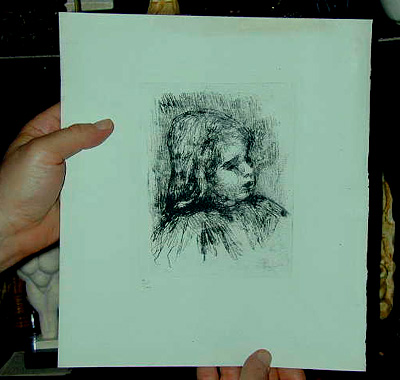
One more delicious Renoir Original for your delight. Please note the greenish color of the paper in the photo above, and also note that original oils, watercolors, sculptures, drawings and charcoals by any of these artists I’ve presented here would cost typically in the millions of dollars. Only by collecting works on paper, especially small editions of multiple signed prints, is affordable by any normal standards. If you’re an abnormally wealthy collector, I do happen to have some interesting items, but you’ll have to call ahead for an appointment. Here’s the most amazing Renoir original work on paper you’ll ever be offered:
PIERRE-AUGUST RENOIR — Stella 18 — CLAUDE RENOIR, DE TROIS-QUARTS A DROITE, 1908 — OF THE UTMOST RARITY, POSSIBLY UNIQUE. Softground etching, 1908, 162mm x 130mm to the platemark on 257mm x 294mm GREEN TINTED Holland Paper watermarked “D & C Blaucw” with the typical ornamental design within, some slight discoloration at the top right, due to age; no tears, no repairs, as issued thus. Two States in an edition of 100, most of which have been lost. PENCIL NUMBERED BY THE ARTIST, 9/100. A LIFETIME IMPRESSION, not stamp-signed by his sons following his death, as was typical of many of the surviving studio prints, some of which were below standard. This is a fine, rich impression on a very unusual paper, and therefore rare and possibly unique. Read on: This study of Renoir’s younger son Claude was originally a pencil-sketch made sometime in the summer of 1908, then a few months later, translated into the etching plate as we see it here. Only a very few proofs were pulled at this time, immediately following Renoir’s visit to his painter friend Victor Roux-Champion. At the end of Renoir’s life, a few impressions were pulled just to test the plate; then in 1923 or 1924 a full edition of 100 was printed and acquired by the famous French art dealer, Sagot. These impressions are numbered in two groups of 50, on different papers, usually a wove stock. This example is not wove, but laid. All impressions of this plate are now extremely rare, but this one — numbered 9/100 — is extraordinarily unique, quite possibly the only one of its kind in the world. THIS IS THE ONLY KNOWN SURVIVING IMPRESSION ON GREEN HOLLAND PAPER. Garrec records a similar impression on Green Holland, numbered 1/100, but it was reportedly lost in the fire-bombing of Dresden during World War II.
My price? It’s gallery-tagged at $138,500, far below what you’d have to pay for any other AUTHENTICATED Renoir unique on the marketplace today. Anyone acquiring this would have a very desirable potential museum donation that could have lots of publicity around it, if it were played right, block-buster style. How? If you want to create a great effect with your local museum the winner, you have but to ask how it’s done. But you must have the item in hand first. Why am I offering these wonderful art objects? Actually, I’m not. The secret is that they’re my loss-leaders, acquired over the past 55 years judiciously and carefully, to lend authority, credibility and interest to my fine art galleries (I’ve had several, along with 6 successful restaurants) and auctions, and I’ve never had a return of anything I’ve sold in the fine art field yet. Why? I make damn sure of my ground before I stand on it and defend it. My real use for these “Million-Dollar Loss-Leaders” is to bring folks to the auction, where they’ll learn about the artists and get a good, deep glimpse into the world of art history — they will be amused, interested and delighted at what they hear. I tell stories about the artists, jokes related to art, and more. The Blue Chip Art is there to tickle, amaze and astound, not to sell. Think about it. I sell my ONLY PAUL GAUGUIN ORIGINAL ETCHING. What am I going to do to get his name back into my auctions? Well, I have to buy a woodcut. They’re expensive, but my complaint is that everyone has them. What I want is “P.T. Barnum Appeal”, meaning a sexy, exciting, even thrilling art discovery, and the fact that it’s for sale to the highest bidder is equally amazing, astounding and thrilling wonder!
===========================================================================
I Don’t Expect You To Do Likewise
Knowing that a number of our folks are interested in learning the art of selling art, I decided to show you the kind of thing collectors are very interested in, but the fact is that they come to an auction for the Cezanne or the Matisse original, but they end up buying lesser known artists because they like the art, once they see it, so — loss leaders.
The thing is, it’s all about WHY people buy art, not about the art itself. Some people are happy putting up a couple of posters with a handful of push-pins, and others want to find the very latest upcoming artist and acquire something before the prices go through the roof, and still others want to collect what others collect, which is most of them.
If you analyze the WHY of art sales, you’ll soon discover for yourself that it’s not about the art at all, nor is it about the artist.
So What Is the Why of Art?
You’ve heard me say: art sales aren’t about the art.
And they aren’t about the artist either—not really.
So what is the why?
I’ve had years to think about it—and here’s where I’ve landed:
People buy art for one of these reasons (and sometimes, all at once):
🧠 1. To See Themselves
Art is a mirror.
They look at the piece and feel seen, validated, understood.
It reflects their longing, their taste, their struggle, their secret.
🧱 2. To Build Identity
Owning art says something.
It signals who they are—sophisticated, adventurous, tuned in, spiritual, edgy, generous, elite, rebellious, whatever.
The art is a brick in the building of self.
🕰️ 3. To Freeze a Moment
A memory, a place, a mood—they don’t want it to pass.
So they buy it, frame it, and hang it up like a spell.
🎩 4. To Belong
Collectors collect because other collectors collect.
Galleries thrive because someone says, “That’s important.”
The art world is a clubhouse, and the art is your secret handshake.
🧭 5. To Feel Alive
Sometimes it’s that simple.
The art hits a nerve, opens a window, zaps them awake.
They feel something rare in a world numbed by noise.
And Here’s the Secret…
Most buyers don’t know why they’re buying.
They feel a pull. A tickle. A little twist in the gut.
And that’s your moment.
Your job as a seller isn’t to explain the art.
It’s to make the moment matter.
=========================================================================
Wow, it’s already time for the Bardo bus! Let’s go!
=========================================================================
See You At The Top!!!
gorby

